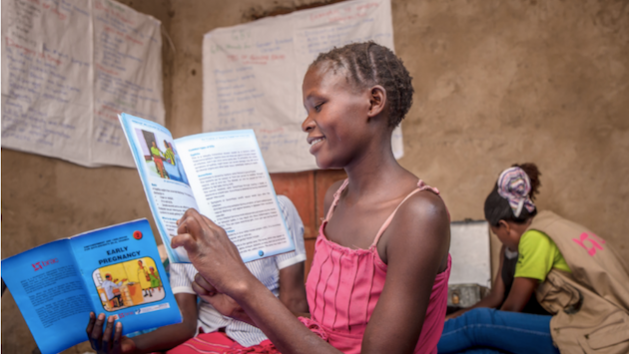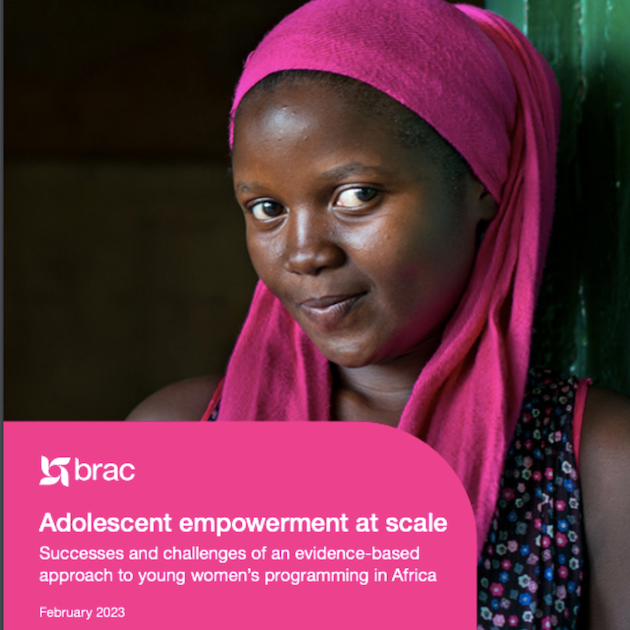BRAC Resets Program Aimed at Empowering Adolescent Girls in Africa

UNITED NATIONS, Feb 22 (IPS) - BRAC’s Empowerment and Livelihood Program (ELA) has benefitted tens of thousands of girls, and its recently released report shows an organization willing to adapt to the circumstances to continue to ensure adolescent girls and young women receive meaningful sexual and reproductive health rights support.
The report titled Adolescent Empowerment at a scale: Successes and challenges of an evidence-based approach to young women’s programming in Africa was launched on February 15, 2023, at a BRAC and the United Nations Population Fund (UNFPA) jointly hosted event. The report was written with the support of the Spotlight Initiative, an UN-led, multi-partner initiative that aims to respond to and eliminate violence against women and girls, with a particular focus on family and intimate partner violence, sexual and gender-based violence, and harmful practices.
The history of BRAC’s Empowerment and Livelihood Program (ELA), which was designed to provide sexual and reproductive health education and livelihood training to adolescent girls and young women, is covered in the report. The program was launched in Uganda in 2006 and has since been implemented in Sierra Leone, South Sudan, and Liberia. During the program’s peak from 2013 to 2015, BRAC hosted over 1800 clubs with over 80,000 members.
“The reason that we partnered with BRAC, have partnered with them in the field… is because of the incredible work that they do in this very efficient, kind of way,” said moderator Satvika Chalasani, a Technical Specialist for UNFPA who oversees programs for adolescent girls and ending child marriage.

Chalasani observed that BRAC had gotten to tens of thousands of women on the African continent through their program, Empowerment, and Livelihood for Adolescents, and it was important to learn from their experiences of 15 years in the field.
Willibald Zeck, UNFPA’s Chief of Sexual and Reproductive Health and Rights, also noted BRAC’s record with youth empowerment programs in his opening remarks while adding that demographic changes in certain regions have influenced how such programs must be designed and implemented. It is estimated that over 60% of Africa’s population is under 25.
“As you know, in UNFPA, we really work across the continuum of sexual reproductive health and rights… And we see in certain regions around the globe the new demographics that are showing that there will be more adolescents in the population, but especially on the African continent. Which is a great opportunity in so many ways, but it also brings more challenges.”
Sarah Tofte, a research and policy consultant, and the report's primary author, presented her findings, breaking down the program’s initial model and implementation and its eventual reset and adaptations.
The report includes findings from academic evaluations conducted by experts, randomized control trials (RCTs) conducted in the regions where ELA programs were hosted, and nearly 100 field interviews with participants and ELA staff.
The findings reveal an overall positive reception and impact on participants and their communities.
Tofte, the co-founder of Understory Consulting, a research and policy consulting firm, noted that the interviewees reported a greater, newfound sense of self through the ELA program, which they connected to making well-informed decisions and contributing productively to the community.
“So based on these positive academic results, and then what I was hearing from field interviews and what participants have been saying over many years, ELA really became a model for other adolescent and youth empowerment programming around the globe, including at the World Bank and at USAID.”
As the report explains, implementation challenges would surface as the program continued. Tofte, the co-founder, noted that while the program’s initial results had been positive, it had slowly ceased to achieve its intended impact.
“By 2017, anecdotal reports had emerged within BRAC about lagging performance of ELA clubs in several countries, including drops in attendance and gaps in the delivery of programming,” she said.
The decline in the program quality and the resulting challenge of sustaining the program over long periods of time also made it difficult to secure funding that would have gone toward addressing the decline. The program had become repetitive for some participants and staff, and issues of deeper community engagement had presented a hurdle for the program’s success.
In 2020, ELA would undergo a “reset” significantly through making fundamental and necessary changes to the curriculum. This would not only update the discussions on reproductive health and livelihood training but would make it more relevant to the economic and social circumstances of the girls they were intended for – while placing more emphasis on providing vocational and livelihood training and financial literacy. Other changes to the curriculum included adjusting the weekly ELA club meetings to optimize engagement and a new graduation model for students to leave the program after one year of completion. The resets were applied at a reduced scale to approximately 140 clubs in the countries where ELA programs were already present.
“Early feedback from this curriculum revamp from the participants suggest that the new curriculum is well received by participants and is driving a positive outcome in attendance and program impact,” Tofte said.
The ELA program adjustments are critical to modernizing the curriculum. What should be of note were the considerations taken to improve community engagement.
“Another big focus of the reset was to deepen community engagement. Prior, a lack of formalized mechanisms for community engagement resulted in some pushback at times from parents of community members who may not have fully bought into the ELA model,” Tofte said. She added that in some cases, the pushback was targeted at the sexual and reproductive health components when the content went against community norms around matters such as child marriage and sexual health.
In response, BRAC, through ELA, has taken measures to establish formal channels with community stakeholders and parents of the participants. By directly engaging with the community’s village elders, religious leaders, and other respected community members, ELA staff members can obtain their support before establishing a program. Formal community leadership committees are also formed, working with ELA staff to ensure smooth operations.
Rudo Kayambo, Regional Director of Africa for BRAC International, pointed out how the findings through field research and the trials were able to be synthesized and focused enough that they could be incorporated into the new program structure, which included paying attention to community members and groups that BRAC did not commonly work with in the past.
“One of the DNAs of BRAC is being able to learn and adapt it quickly,” she said. “…We have now managed to integrate all the lessons into a bigger multicultural program, and some of the key lessons were that they need to support the frontline workers.”
When asked to elaborate, Kayambo added that BRAC would provide technical training and the infrastructure to help monitor and use digital technology. “ are the heart of delivering the value of the ELA program and all its components.”
Another significant change to the rollout of the new ELA program was the introduction of sexual and reproductive health programs targeted at adolescent boys. Boys were included in the program partly to fill a gap in youth-empowerment programs that had thus far been only directed at adolescent girls and women. Through a series of RCTs conducted in 50 rural communities, trial programs similar to ELA were conducted with boys and young men, targeting them specifically.
“ the need to also incorporate adolescent boys and young men, because that formalizes our commitment to getting community buy-in,” said Kayambo.
Manisha Shah, a professor of public policy at UCLA who worked with BRAC to conduct the randomized trials, elaborated that the rationale was to include boys since they were already involved in the decisions and issues that girls and women had to contend with when it came to their health.
“Unless we get these boys on board with the agenda, it’s going to be really hard to think about how we improve the outcomes related to female sexual reproductive health,” she said.
A follow-up survey conducted in those communities two years after the trial programs ended revealed a decrease in intimate partner violence between 20 percent and 60 percent, with a “significant change in these boys’ attitude around violence” and an overall more positive reception and understanding of sexual and reproductive health.
“This just proves that we also need to be targeting the other side of the coin, which is the boys and the young men,” Shah said.
The event also showcased how other organizations partnered with BRAC through the ELA program, such as other NGOs like the Bill and Melinda Gates Foundation. The Foundation’s deputy director for women’s empowerment Diva Dhar remarked that it was critical to recognize that adolescents deal with “really important transitions on school to work, to marriage, to financial, economic independence, to employment.”
“ are a very important age group… because that attitudes and norms crystallize at this age and can have long-term implications, including for future generations,” Dhar said.
When looking at women’s economic empowerment, Dhar stated that further causal evidence would be needed to explore the intersections between economic independence and family planning and health outcomes.
For the Gates Foundation, this has involved investing in programs that build up skills and training for girls and women, including non-traditional opportunities that will build empowerment.
The ELA program in Africa is a testament to BRAC’s success as an NGO, given its ability to inspire similarly multifaceted youth-empowerment programs and its model to evolve and improve their work. However, the report makes it clear that this is achievable through the continued support from partners and donors and from fostering community engagement. Only then can the communities’ women and girls be empowered through the knowledge and skills they obtain through the program.
“One of the key findings we are taking from this is that the role of mentors and community assistance are so important,” Kayambo said. “We are creating room for them to engage from an empowered perspective, and building their own agency, to give room for them to engage and build themselves up before they can empower others in the community.”
IPS UN Bureau Report
Follow @IPSNewsUNBureau
Follow IPS News UN Bureau on Instagram
© Inter Press Service (2023) — All Rights Reserved. Original source: Inter Press Service
 Global Issues
Global Issues